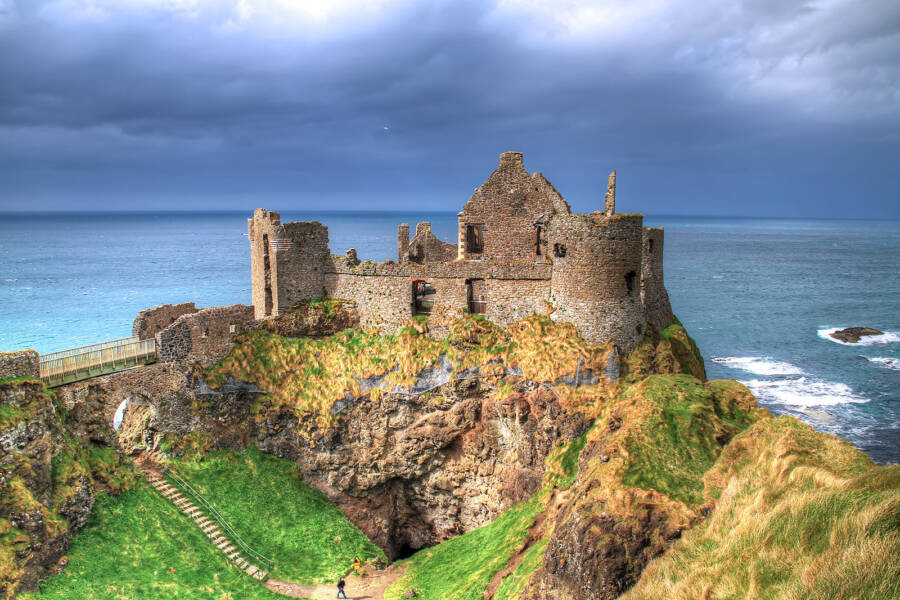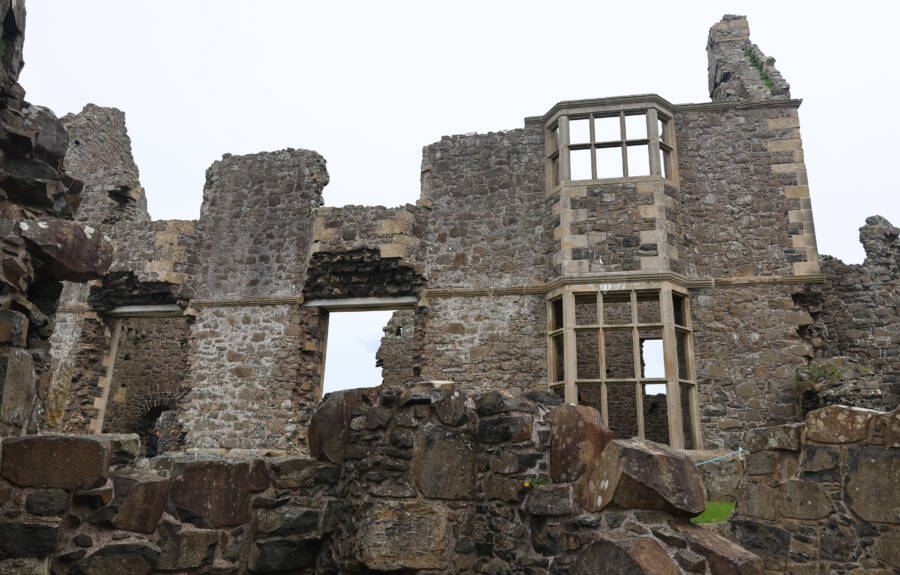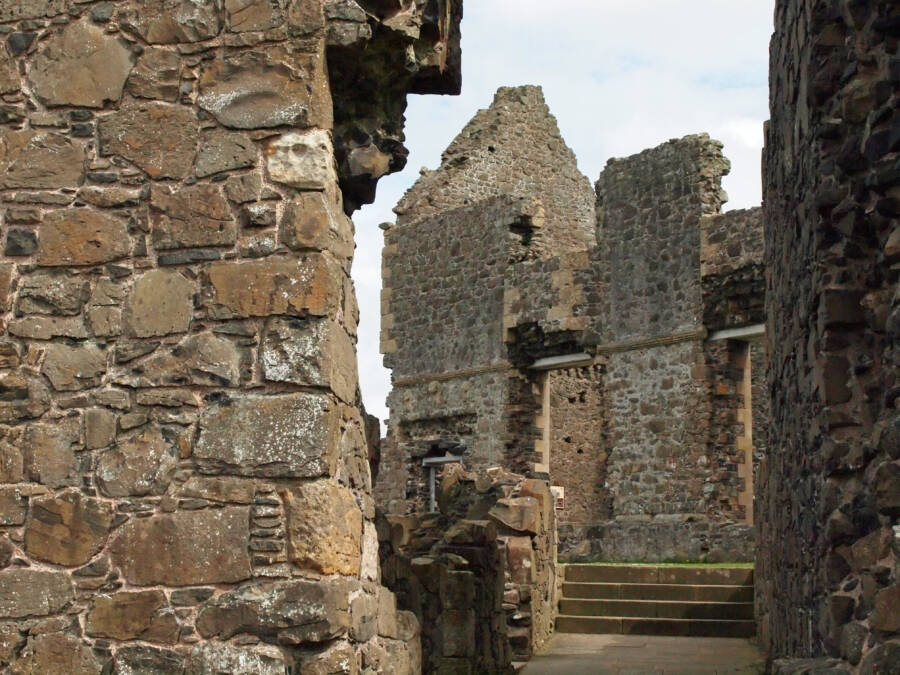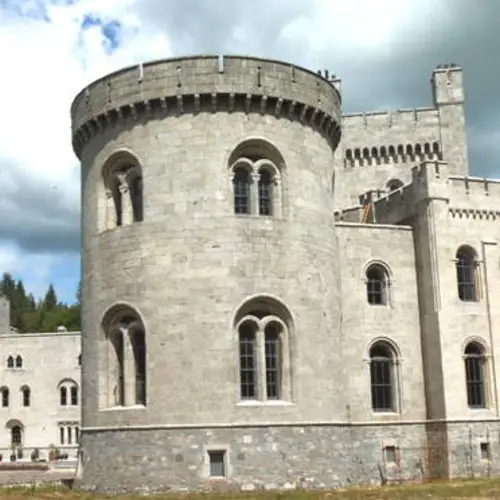Though the centuries have taken their toll on Dunluce Castle — a ruined fortress that sits on the seaside cliffs of Country Antrim — it remains as awe-inspiring as ever, drawing tens of thousands of visitors each year.
Whether you realize it or not, you've likely seen the iconic ruins of Dunluce Castle, perched atop a craggy Irish rockface.
It's made appearances in Game of Thrones and on the gatefold artwork of Led Zeppelin's album Houses of the Holy (alongside the ancient volcanic formation known as Giant's causeway.) It was even the inspiration for the citadel Cair Paravel from Chronicles of Narnia.
However, there is clearly more history to this castle than just that of the pop culture variety.
Part of its complex history is the people who called it home and the village that once existed around it. Aside from the politics and wars, there were fun times too — evidenced by Dunluce Castle's annual fair closing due to excessive debauchery.
Adding to the mystique, legends swirl of a resident banshee, upset about her lost love and untimely death.
Read on to learn more about this fascinating castle with essential ties to Ireland's history and politics.

Radu Micu/FlickrIn the 16th century, Dunluce Castle was at the center of the decades-long rivalry between the MacQuillan and O'Cahan clans.
The Stunning Location And Architecture Of Dunluce Castle
Set on its foundation of a medieval basalt outcropping, the ruins of Dunluce Castle overlook the crashing waves of Ireland's North Atlantic channel. It's located in county Antrim, the closest town being Bushmills — home to the famous distillery of the same name.
The castle is comprised of two main parts; the mainland's outer buildings and the castle core. Each is now connected to the other by a stone bridge where an old drawbridge once was.
Furthermore, there are two corner towers originally used for defense, each 30 feet in diameter. Inside the gatehouse was the home of two cannons originally seized from a Spanish Armada ship named Girona.
Underneath the cliffside is a small opening in the rocks called the Mermaid's Cave. The location was probably used for attacks and escapes, as it is almost invisible from above.
Archaeologists have uncovered a small area of the surrounding village. They found evidence of horse stables, guest lodgings, and a brewery. However, much of the town remains unexcavated.
The Historic Tenants Of Castle Dunluce
Richard de Burgh, 2nd Earl of Ulster, is the most probable builder of the original castle in the 13th Century. Other records indicate that either John de Courcy or part of the De Maundeville family may have had a hand in its construction. Either way, the MacQuillans — the Lords of Route — were the first documented family to live in Dunluce Castle in 1513.
Originally allies, Clan MacQuillan and Clan MacDonnell became sworn enemies after a betrayal by the latter. Many conflicts ensued, and eventually, the MacDonnells ousted the MacQuillans and secured the castle. The McDonnells became the dominant family of Antrim.
This setup lasted only a short time, however. England's Queen Elizabeth I then besieged the castle, as she was reportedly jealous of its local power. Ultimately, she returned it to Clan McDonnell — under the condition they swear allegiance to her.
Regardless, the rebellion known as the Nine Years War put all of Ireland under England's rule in 1603.
In 1641, an Irish Army took over Dunluce Castle and burned the surrounding village to the ground. Then, in 1690's Battle of the Boyne, the MacDonnells were forced out, and the castle was completely abandoned. All the ravages of war took their toll, and the once lovely residence is now essentially in shambles.
The MacDonnells still technically own the property today, but it is under a protected status. The Northern Ireland Environment Agency maintains the castle and surrounding land.

Dieglop/Wikimedia CommonsCows graze outside Dunluce Castle.
Legends And Legacies Of This Storied Fortress
Perhaps the most interesting legend surrounding Dunluce Castle is the ghost of Maeve — the sole daughter of Lord MacQuillan.
The lord banished young Maeve to one of the castle towers because she refused an arranged marriage to a lad named Rory Óg, as the tale is told. Maeve already had a secret beau named Reginald O'Cahan — and the pair planned an escape together. The tale is particularly reminiscent of Romeo and Juliet, as the MacQuillan and O'Cahan clans were bitter rivals.
On a dark and stormy night, Reginald came for Maeve, and the two escaped by hopping into a waiting rowboat outside Mermaid's Cave. However, the seas were treacherous, and the boat flailed about — eventually overcome by waves. The young lovers were tossed out of the rowboat and sank into the salty Atlantic waters.
Since then, people report hearing the cries of Maeve inside the castle, as well as the sounds of phantom broom sweeping in the tower where she was kept.
There's also a legend that part of Dunluce Castle fell into the ocean. It's purported that part of the kitchen, situated right above the mermaid's cave below, crumbled down in 1639. People say that a kitchen boy seated in the corner of the room survived, but other workers there crashed with the stones into the waters below.
However, paintings from the late 18th and early 19th centuries suggest that part of the castle was fully intact.
Even without the help of myths, Dunluce Castle remains one of the most fascinating buildings in Irish history.
Next, find out more about Ireland's iconic Blarney Stone. Then, explore another historic fortress from the middle-ages, the Castle of Edinburgh.

































